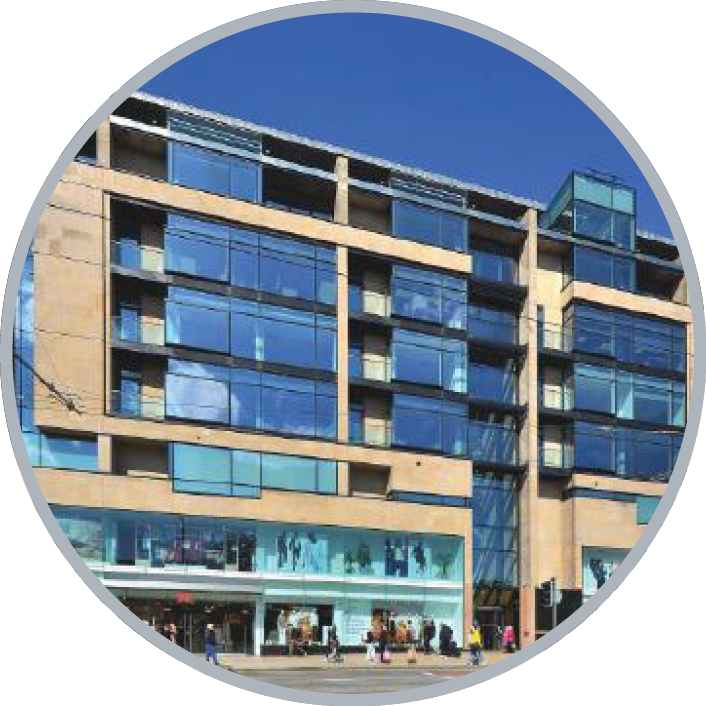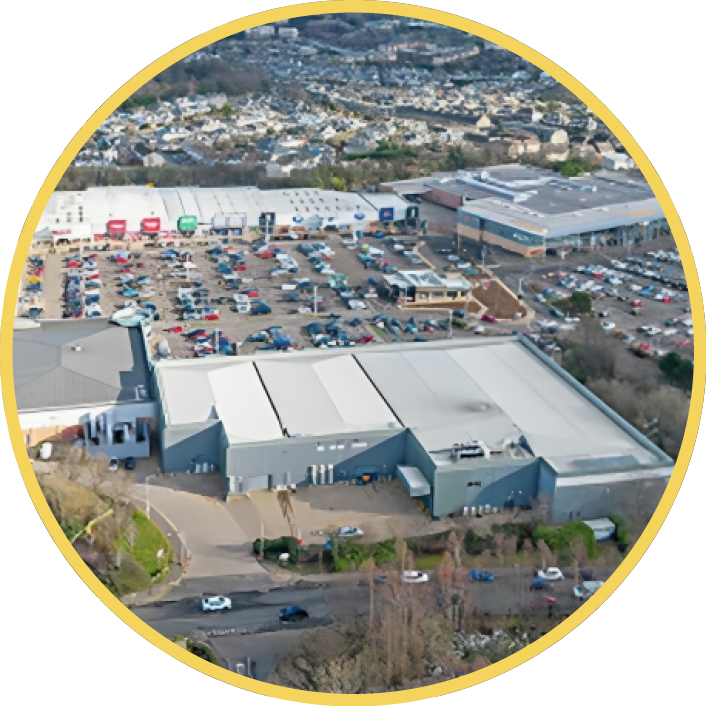
“Rugby is great! The players don’t wear helmets or padding; they just beat the living daylights out of each other, and then go for a beer. I love that.”
– Winston Churchill
By the time this edition goes live, the Rugby World Cup will be well underway but trying to predict the eventual winner is almost as difficult as trying to call the property market at the moment.
While there are encouraging signs at a macro-level (interest rates peaking, inflation easing and build costs plateauing), it still feels like there are some challenges ahead, particularly for those with historic debt, grappling with the prospect of more expensive re-financing. The market will settle, and we are anticipating an improvement in investment volumes and confidence over the next 12 months.
The recovery is unlikely to be uniform across all sectors but one sector that seems to have weathered the storm better than others and is well placed to see improvement is multi-let industrials. Good letting prospects, less CAPEX hungry and a lack of new development all make for compelling investment rationale.
So, in addition to our regular quarterly analysis, the focus in this review will be on multi-let industrials – what is driving the occupational market, how strong is investor appetite and are we likely to see capital growth in the short term. To help us shape our thinking, we are pleased to share a Q&A piece with Will Lutton, Head of Investment at Industrials REIT, one of the leading multi-let industrial businesses in the UK.
As for the winner of the Rugby World Cup – the bookies have France, New Zealand, South Africa & Ireland as the main contenders all around odds of 4-1. We preferred Scotland at 80-1, unfortunately it doesn’t look like that’s going to pay out!
Market Overview.
Key Themes
“Old” money to the fore – as debt remains expensive, the long-established property companies and family offices (with little or no requirement for bank involvement) are increasingly active. Usually a positive sign that we are somewhere close to the bottom of the current cycle.
Increasing stock levels – after a period of limited product, more stock is openly coming to the market. A combination of more encouraged selling and an acceptance of today’s pricing helping to ease the log-jam.
EPC legislation changing –which will bring the current system in Scotland more into line with England/Wales. This can only be good news – eradicating the current differing systems but also helping to improve some ratings which, historically, have been lower in Scotland.
Hospitality bounce-back continues – particularly in Edinburgh where hotel/ short-term stay room rates and occupancy levels are well above pre-Covid levels. This backdrop has helped a number of older office opportunities trade for alternative use, namely hotel.
Retail park liquidity – the sector continues to be one of the most liquid, particularly for larger dominant urban parks and smaller value-led opportunities. While the pool of buyers is not that deep, there is a range of active buyers (including UK Funds) although they are still struggling to compete with the voracious appetite of the North American REIT.
Transaction Volumes
Q3 saw £398m traded up 17% on Q3 2022, with a number of larger transactions resulting a more positive quarter than anticipated.
Q3 volumes were 8% below the 5 year average.
With the end of 2023 fast approaching, we are seeing a increase in stock coming to the market, however Q4 volumes are likely to be lower than the 5 year average.
No Data Found
Pricing
The gap between buyers and sellers has closed significantly, as reality hits that the significant adjustments seen over the last 18 months are here to stay. Confidence remains elusive but at least there is an acknowledgement that we are starting to “find a level” where valuers are more comfortable. Investment Committees and Credit Committees remain particularly vigilant and any bidding on new product is generally erring on the side of caution.
Logistics and multi-let industrials remain stable, with the backdrop of occupier demand holding up, rents still growing (in prime locations) and limited new development, sentiment to the sectors is generally positive. Prime yields for logistics have stabilised at 5.75%-6% and multi-let industrials at 6.5%.
Offices remain the hardest sector to call with a real divergence of opinion on future prosects and where true value lies. The lack of transactions tells you everything. Prime yields will need to start at 6% and the recent sale of 40 Princes Street in Edinburgh has shown that for good quality core plus assets 7.5%+ is the mark.
Retail warehousing looks like offering good value. For urban parks and those anchored by value occupiers, prime yields have softened to between 6.5%-7% with signs that there is a deepening pool of buyers. On the high street, again the limited number of transactions is telling but for the best product, well let, then 6.5% is being achieved.
In the Living sector, appetite remains robust, but the number of relevant transactions has been limited. Whilst there has been no recent evidence in the BTR sector, prime yields feel closer to 5% than 4.5% and 5.25%-5.75% for prime PBSA.
Investor Activity
Fund activity remains selective and quite opportunistic. While the Living and Logistics sectors continue to be supported by research teams and Investment Committees, we are seeing other sectors including retail warehousing and leisure (with yield) coming into focus. Overall, we see them continuing to be net sellers but attractive pricing in some sectors is starting to catch their attention.
Core-plus buyers are starting to see some value in offices, leisure and retail warehousing where values have fallen to a level that debt can be accretive, c7.5%. Stock selection remains paramount, but it feels like the well-financed buyers in this space are starting to become more active.
The patience shown by opportunistic buyers looks like it will be rewarded in the not too distant future. While we do not anticipate a wave of forced selling, the new world of more expensive debt is here to stay for the foreseeable future which will start to loosen stock over the next 12 months.
Key Recent Transactions.
Q3 saw some interesting themes and significant transactions which we have highlighted below:

Livingston Designer Outlet, Livingston
“World’s largest asset manager sells Scotland’s largest outlet centre”
Vendor: Blackstone
Purchaser: Global Mutual & Patron Capital
Let to: Multi-let
Price/Yield: £57m / 14.00%
Date: September 2023

40 Princes Street, Edinburgh
“Overseas investor acquires first UK asset”
Vendor: Redevco
Purchaser: Remake Asset Management
Let to: H&M, Cubo, Red Rock Power, Canaccord Genuity Wealth, Cadence
Price/Yield: £29.525m / 7.50%
Date: August 2023

Craigleith Retail Park, Edinburgh
“US investor adds to growing Scottish portfolio”
Vendor: Nuveen
Purchaser: Realty Income Corporation
Let to: Multi let anchored by M&S, Homebase and Lidl
Price/Yield: £62.50m / 7.50%
Date: August 2023

51 McNeil Drive, Eurocentral
“Pension fund manager acquires prime industrial asset“
Vendor: Capreon
Purchaser: Wesleyan Assurance
Let to: Biffa
Price/Yield: £6.74m / 6.20%
Date: September 2023
The investor view on the multi let industrial sector:
Over the next 12 months, do you expect prime multi-let industrial yields to: harden, soften or remain stable?
No Data Found
46% of respondents expect prime yields to remain the same over the next year. It was noted that forecasting in the current market is far from straightforward and only a sustained increase in transactions will provide clarity on prime yields.
Over 50% of respondents from property companies and funds anticipate yields remaining the same, with 56% of investment managers expecting yields to harden over the next 12 months.
With prime yields having moved out by 150-200 bps, the sector should provide opportunity for the weight of capital targeting the sector to acquire prime assets offering genuine value.
No Data Found
Location was identified as the key driver of occupational demand by 54% of respondents, with macro-economic sentiment a distant second on 34%. Interestingly, total occupational costs was a distant 3rd on 9%, suggesting there is potential for rental growth to continue its upward trajectory.
Whilst the economy is still facing well publicised head winds, recent economic indicators are providing a degree of positivity, with core inflation falling and the Bank of England opting to keep interest rates stable, after 14 consecutive increases. Business expansion plans are likely to be influenced to a large degree by the continuing economic recovery.
Only 3% of respondents identified ESG credentials as the key driver, with 66% selecting ESG as the least important factor. At a time when tenants in other sectors (in particular the office sector) are helping to drive the ESG agenda, sustainability in the multi-let sector continues to be driven by landlords.
Are multi-let industrials on your buying list going into Q4?
No Data Found
Over two thirds of respondents will be hunting for buying opportunities in the sector during Q4, and although the pricing disconnect between sellers and buyers persists, it was noted the gap is narrowing with pricing beginning to find it’s level.
Of those on the acquisition trail, 88% of investment managers and 69% of property companies are targeting the sector attracted by the relatively soft yields on offer.
With a number of multi-let estates either on the market or quietly available, those investors seeking multi-let industrials should find some opportunities in Q4 and judging by our survey results, perhaps some competition too!
“Expert view” on the multi-let industrial sector…

Will Lutton
Head of Investment
Industrials REIT
Industrials REIT is a leading multi let industrial platform acquired by Blackstone in mid 2023 for over £700m with over 7m sq ft under management and a gross portfolio value of c£500m.
The Blackstone acquisition allows you access to greater firepower. Will you continue to target similar sized assets to what you have in your existing portfolio or are you expected to target larger estates/portfolios going forward?
It’s going to be a combination of both. We have ambitious growth plans so portfolio acquisitions will form the lion share of transactions by value, but the MLI (multi let industrial) market remains fragmented and we have always seen value in aggregating smaller individual estates along the way and we want to continue to benefit from this.
When inflation comes under control and rate hikes are paused do you expect to see yields strengthen?
Yes, when the underlying risk free rate starts to come down as central banks get comfortable that inflation is under control and we move into a more normalised debt market, yields are likely to harden. In the short term, we expect rates to remain high and economic conditions to be uncertain, which may to lead to investment opportunities for well capitalised investors as others struggle to refinance existing holdings.
The occupational markets have held up well so far, do you expect that to continue?
Our internal data remains positive, both in terms of rental growth and low levels of vacancy over the last few months. We are also seeing sustained levels of occupier interest through our Industrials Hive operating platform and benefit from waiting lists on several buildings. This internal data is incredibly useful for the Investment Team as it allows us to be confident in our underwrite and present a data driven assessment to our board when seeking to acquire new assets. Most importantly, our rents remain highly affordable to our customers, with our internal analysis estimating that rent accounts for just 2% of a typical customer’s turnover.
Are you seeing rental growth across all locations or only the strongest? Do you expect to see stronger rental growth in new build or second hand stock?
Yes, we have seen good growth right across the UK, and that is because many of the same market dynamics are at play; obsolete stock coming out of the market and being re-developed for other uses, little new MLI development coming on stream and continued high levels of occupier demand. We see a long runway for continued rental growth whilst these conditions prevail and rents remain affordable. We don’t see significant premiums being paid for new space compared to second-hand stock, largely because we invest in our buildings so they present well and fulfil our typical customer’s needs. By implementing energy performance improvements during our refurbishment programmes we are also able to stay ahead of environmental legislation and meet the sustainability needs of our customers.
How important is access to reversion early on in your hold period?
It is important, especially with where debt rates are sitting vs property yields at the moment. However, with multi-let industrial estates we typically benefit from a diversified lease expiry profile which allows us to capture rental reversion throughout our hold period. This is one area where existing assets have an advantage over brand new ones, as there tends to be a few years of embedded rental growth to be unlocked.
What ESG initiatives are you implementing on your estates?
What we realised early in our ESG journey is that, like many things across business, the quality of your data is incredibly important. We have spent a lot of time focusing on where we are now, so we can accurately measure the impact of our sustainability initiatives on our carbon footprint. Going forward, there are three key areas of focus:
- Aligning our aspirations with our customers through the inclusion of Green Lease drafting in our short form Smart Lease. These aim to help the business reduce its carbon emissions, and better track and analyse its carbon footprint.
- Improving EPC ratings to a minimum EPC B, both on our existing portfolio and any new acquisitions. The simple nature of MLI estates helps us here as we can achieve the necessary improvements through simple and cost effective solutions such as LED lights, removal of gas fired heaters and inclusion of movement sensors in our units.
- And finally, with over seven million sq ft of roof space the business has a significant opportunity to deploy rooftop solar, allowing our customers to benefit from renewable energy whilst also helping us to further improve our EPC ratings.
“Our view”on the outlook for the multi-let industrial sector…

Chris Macfarlane
Director
Lismore Real Estate Advisors
Market Sentiment
No sector has been immune from the wider macro-economic challenges and the effect that they have had on the market, however, it has not been a uniform slow-down. While the logistics, office and retail markets have seen more significant adjustments, the multi-let industrial sector has fared better. A combination of occupier demand holding up, very little new development, good rental growth prospects and comparatively limited capex requirements has ensured that the investment rationale still makes sense and the buyer pool has remained deeper than other sectors.
What are the prospects for rental growth?
On the face of it, the basic numbers can make a compelling case. Across the central belt, the overall vacancy rate is currently running at c3.5%, with new build even tighter at less than 1%. Take-up during 2022 totalled c4.35m sq ft on a par with 2021 (which was also a particularly strong year). 2023 looks like a slightly quieter year but with the continued constraint on new development, pressure on rents remains.
Average rental growth over the last 5 years has been running at close to 5% pa, rising closer to 10% pa in hot spots such as west Edinburgh, Eurocentral and the M73/M74/A725 corridor (south and east of Glasgow). While we do not see these sorts of levels as sustainable in the long term, we do see rental growth continuing in the strongest markets (sub 5%) with the wider market easing further back to something like the longer term average of 2-3%.
Will we see any improvement in the development pipeline?
The short answer is “no”! There is currently less than 500,000 sq ft of new space available across the central belt and at least 50% of this will be let during the remainder of 2023.
There are several larger proposed developments (EDI Approach on the west side of Edinburgh) and Orchard Park at Eurocentral but they remain some way off and realistically, the pipeline for traditional multi-let estates will be limited to smaller in-fill sites capable of housing up to 50,000 ft in total.
There are some signs of build costs plateauing but with development finance remaining challenging and yields still finding their stabilised level, the development pipeline will remain significantly constrained in the short term at least.
What are the prospects for capital growth in the short to medium term?
Prime yields for multi-let industrials peaked at c5.25%-5.5% in late 2021. Since then the market has clearly softened (particularly during early 2023) but the dearth of comparable transactions over the last 12 months has made it difficult to accurately pinpoint where prime yields currently stand. Our view is that the market has moved somewhere in the order of 20% over this period and we would be guiding in the order of 6.5% if the right opportunity was available.
In line with most of the other sectors, we see yields generally stabilising over the next 12 months. It would be unrealistic to expect capital growth in the short term but, as a sector, we see it better placed than others to benefit as confidence starts to return to the market.
What about Aberdeen?
Industrial take-up during 2022 totaled c950,000 sq ft, 43% up on the 5-year average. To quote a local letting agent “there aren’t enough hours in the day”. The conflict in Ukraine and the price of a barrel of oil hovering above $90, has rekindled North Sea activity and the occupational market is as strong as it has been for more than 5 years. It truly is a contra-cyclical market!
The challenge remains investor perception. While the occupational story is robust, some investors remain to be convinced on the City’s long-term viability. Our view is that, while the City has had recent challenges, the longer-term outlook (particularly in the multi-let industrial market) is brighter. A more diversified occupier pool, not wholly reliant on oil, has emerged and is growing. Debt is a challenge but for those investors looking for higher returns, the case for Aberdeen is about as strong as it has been for some time.
Looking to the future…
Yields will stabilise into 2024.
Investment volumes will increase in the sector as confidence starts to return.
Industrial open storage (IOS) has not emerged in Scotland as yet but this can become an interesting play for investors, particularly for older estates with surplus (useable) land.
Aberdeen will see more activity as yield-hungry investors are attracted by the continuing strong occupational story and double-digit initial yield returns.
With the recent announcement of two new Green Freeports in Inverness/Cromarty Firth and Firth of Forth, it should give an additional boost to key industrial markets in Inverness, Leith, Grangemouth and Rosyth.